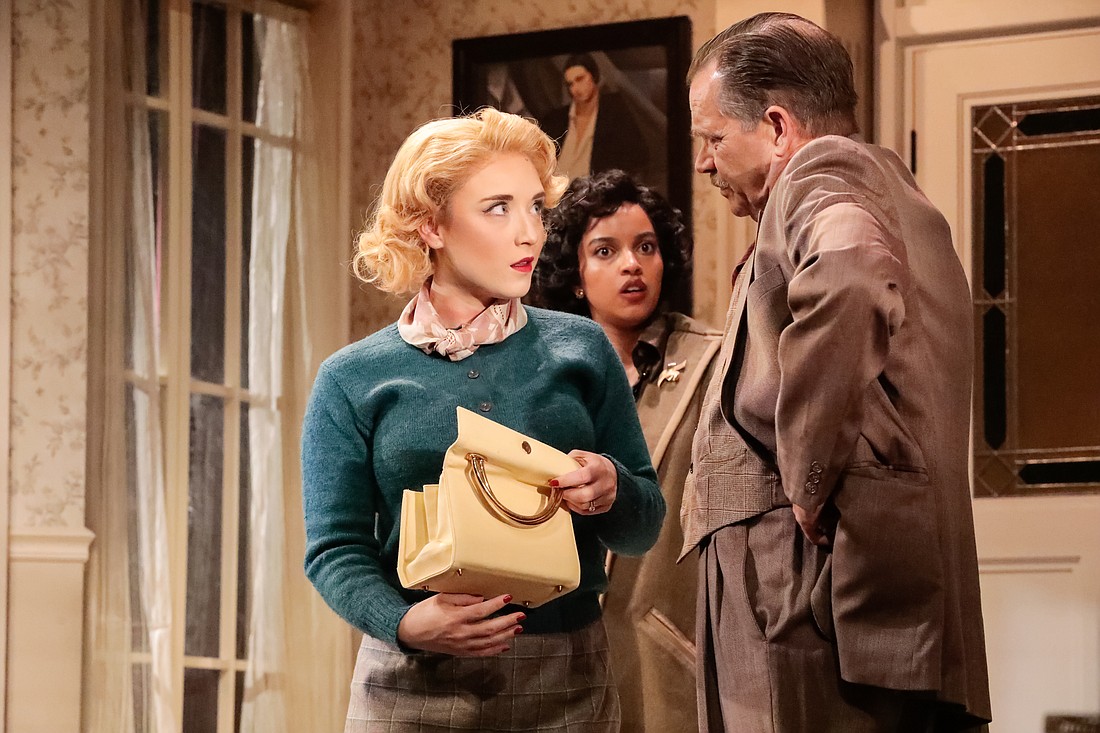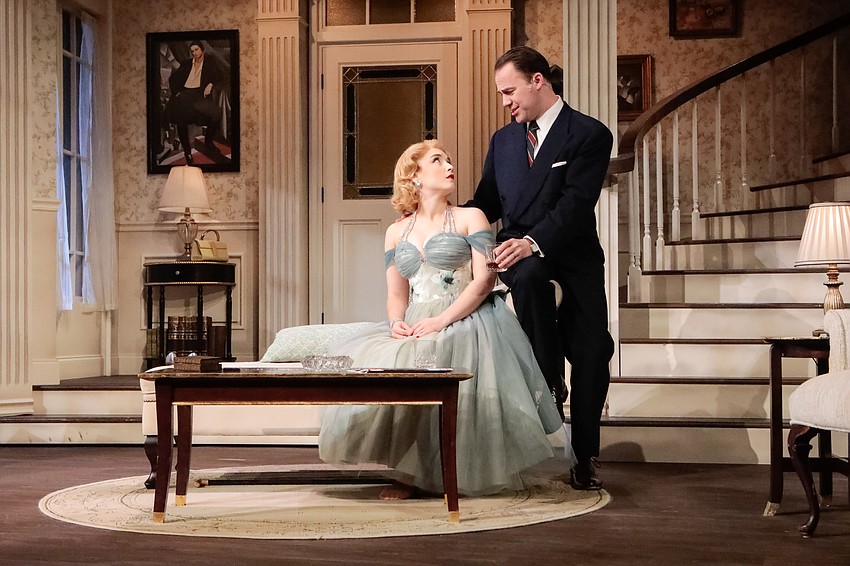- May 7, 2025
-
-
Loading

Loading

Frederick Knott’s “Dial M for Murder” was a hit play in 1952; Alfred Hitchcock’s film version was a hit in 1954. Playwright Jeffrey Hatcher’s 2022 stage adaptation takes electrifying elements from both versions, and adds some high voltage all its own. That said, the play’s basic wiring remains the same.
London in 1952 is the place and time. In Hatcher’s retelling, Margot (Brooke Turner) is married to Tony (Tony Carter), a failed writer reborn as a successful literary publicist. Maxine (Zia Lawrence) is his hottest client, an American author of best-selling thrillers. Interestingly enough, Maxine was also Margot’s lover. Margot broke off the affair a year ago, but kept one sizzling love letter.
Tony got his hands on it, and concocted an elaborate Machiavellian scheme to kill Margot and get his hands on her fortune. He maps out the moves with a chess master’s deft strategy. It’ll be the perfect crime! Nothing could possibly go wrong! And, of course it does. That’s when things get very interesting. (And subtly different from the earlier versions.)
New version or old, “Dial M for Murder” has a lot of moving parts, not to mention bells and whistles. To put it in plain English: it’s complicated material. Director Céline Rosenthal keeps her eye on the ball. The audience never gets lost. Plot points fly, but she always keeps the action clear.
The actors embody their updated characters with no anachronistic slips. Turner’s Margot puts a 21st-century twist on the midcentury archetype of an upper-class housewife. She seems guilty about the affair, though not that guilty. She seems to love her husband, though not too much. Her Margot isn’t a yes-woman.
Lawrence’s Maxine is sexy and sharp, but no femme fatale. Mark Benninghofen’s Inspector Hubbard is the classic trope of a seemingly absent-minded detective who’s actually sharp as a tack. It worked for Peter Falk’s Columbo. It works for Benninghofen’s character, too.
Mikhail Roberts’ Lesgate might as well have “fall guy” tattooed on his forehead. This low-rent crook is the perfect patsy for Tony’s blackmail/murder scheme. Like some satanic Santa, Tony’s catalogued all of Lesgate’s naughty deeds. Then he gets him alone — and reads them off one by one. Lesgate cringes like a hooked worm. Roberts makes you feel for his character.

Carter’s Tony is a piece of work. Outwardly, he’s a refined intellect. Inwardly, he’s a cunning, calculating superman. In Roberts’ portrayal, Tony is a genuinely terrifying individual. His character is a sociopath, a brilliant improviser, quick on his feet, self-centered and utterly heartless. It’s almost time to talk about Tony. But first here’s a nod to the talents who bring this film noir world to life:
Antonio Troy Ferron, the set designer. Only one set. It all takes place in Tony and Margot’s living room, no place else. Ferron’s abode has an ivory tower feel to it. This upper-class couple lives in a world of their own. They’re above the tide of humanity — but far from safe.
Aside from being a feast for the eyes, Tracy Dorman’s costumes accurately capture the wearable semiology of that era’s class structure. Mark Rose’s fight choreography doesn’t look like fight choreography. In his hands, the play’s murder scene feels like random real-life action, not a dance. That’s the way it’s done. Kudos to all.
Now let’s talk about the sociopath in the room. Hatcher’s Tony has a superman complex. Make that “super-villain.” He’s a charismatic monster, no doubt. Hatcher’s script deliberately compares him to Richard III — the template for all charismatic super-villains. Tony 2.0 charms the characters on stage — and chills the hearts of the audience. He’s bad to the bone with no shades of grey.
In Hitchcock’s movie, it’s not that simple. Hitch liked to play mind games with the audience. His 1954 movie kept shifting loyalties and sides. Some scenes made you sympathize with Tony. He’s the victim of adultery, after all. His outrage is understandable.
In Hatcher’s version, it isn’t. Tony married for money; now he’s killing for money. The man is a rotter, plain and simple. And his rottenness drives the storytelling.
Ironing out Tony’s ambiguity simplifies the play. It doesn’t make it better. Tony’s inhuman — and that kills the human factor. What’s left? Ah … The convoluted complications of Tony’s scheme. An intellectual puzzle. A Rube Goldberg machine. A mousetrap.
Curious about the specifics? You’ll find out. From the horse’s mouth.
Like all super-villains, Tony loves to talk. He unfolds the details of his convoluted plot (spoiler alert) in the scene where he blackmails Lesgate into killing Margot and making it look like a botched burglary.
Tony gleefully lays out his scheme’s intricate steps with bewildering precision. Hide the key under the mat, do this, do that. Brilliant, sure. But if even one teeny, tiny, little thing goes wrong, it’ll all go to hell.
And you know it will. Tony’s perfect crime is just too damn complicated. Which makes his hubristic fall too damn predictable.
Without the human factor, the game of “murder by the numbers” is just not interesting. I enjoyed the play’s intellectual puzzle, don’t get me wrong. But it could have been better.
This problem is the playwright’s problem. Hatcher is brilliant, but he got the wrong number with “Dial M for Murder." The Asolo Rep’s talents don't. They keep you on the edge of your seat.
The fault is in the script, not on the stage.